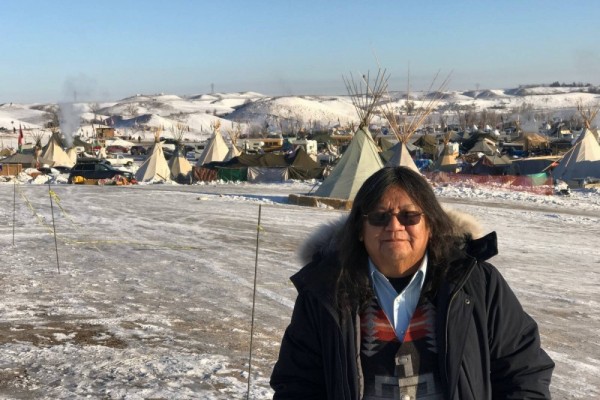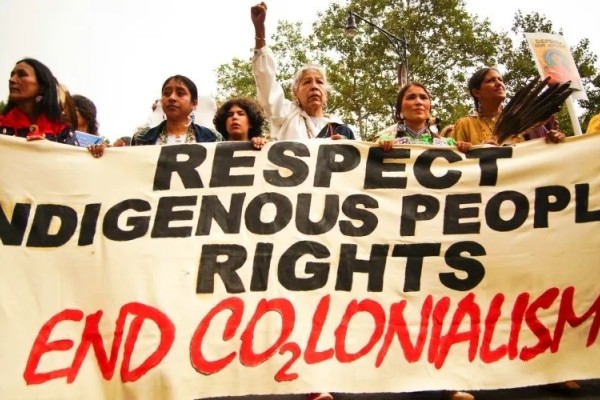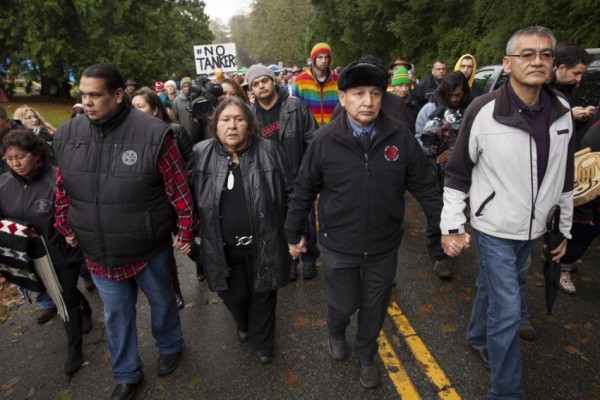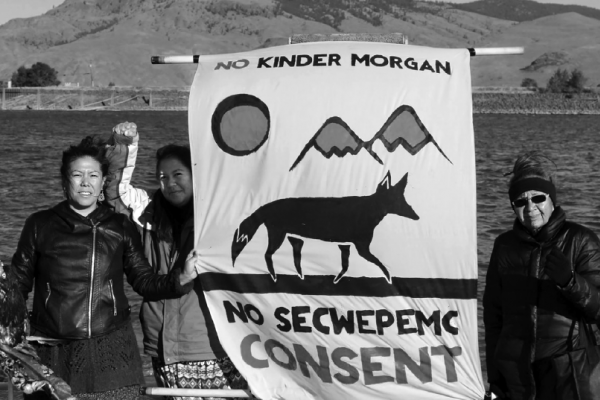There is no honour in the Crown
One First Nation takes on the Ontario Mining Act

Members of the Kitchenuhmaykoosib Inninuwug (KI) indigenous community protest at the Ontario Legislature, 2009. Photo from Flickr.
On May 28, after more than two months in jail, six members of the Kitchenuhmaykoosib Inninuwug (KI) First Nation in northern Ontario were released following a decision by the Ontario Court of Appeal. On March 17, KI Chief Donny Morris, Deputy Chief Jack McKay, councillors Sam McKay, Darryl Sainnawap and Cecilia Begg, and band member Bruce Sakakeep had been sentenced to six months in jail after they interfered with drilling for platinum on their traditional lands.
Despite their release, the problem for KI and other Aboriginal communities in Ontario remains essentially the same. There is a fundamental conflict between provincial law, which grants unfettered access to land in Ontario for mining development, and the government’s obligations under treaty to honour First Nations’ relationships to their traditional lands.
Located 580 kilometres north of Thunder Bay on Big Trout Lake, KI is an Ojibwa/Cree community that has occupied and used their traditional lands since time immemorial. Across the lake from the KI reserve, mineral exploration for potential nickel and chromite deposits began in the late 1960s. Results of early exploration did not favour development at the time, but in 1999 a new, junior exploration company, Platinex, became interested in platinum potential that earlier surveys may have overlooked, obtaining 221 contiguous mining claims in the vicinity of Big Trout Lake.
Current Ontario legislation prioritizes mining development over responsibilities to Aboriginal peoples. The Ontario Mining Act is based on what is referred to as a free-entry system. This system allows the mining industry to access the majority of the land in the province and make claims without consulting land users. This system fails to recognize the nation-to-nation relationship between the Crown and First Nations as treaty partners, and violates the government’s constitutional duties to consult with First Nations prior to making decisions that might affect their interests.
Jurisdictional games
This also reflects the jurisdictional games played by the federal and provincial governments, which share sovereignty of the Canadian state. The provinces are slow to accept the obligations the courts impose on governments, invoking their jurisdiction over resources and the federal government’s jurisdiction over “Indians and lands reserved for Indians.” This is disingenuous and violates constitutional law. It also stretches conflicts out while development proceeds – and it forces First Nations to dig deep into shallow pockets to pay for legal challenges, even as the Canadian public pays for governments, via taxes, to litigate challenges to Aboriginal and treaty rights literally for generations.
In Ontario right now, First Nations communities are not recognized to have a right to determine what kind of development, if any, occurs on their traditional lands. First Nations communities, in the words of KI’s lawyer, Chris Reed, “do not ever have the right to say no to mining or mineral exploration.” He describes First Nations communities faced with a mining company exploring their land as possessing three options: be quiet and do nothing, negotiate a deal that mitigates the impacts and shares some of the benefits, or resist and go to jail.
The James Bay Treaty
KI is a signatory to the 1929 adhesion to Treaty 9, the James Bay Treaty. KI councillor Sam McKay states that his ancestors agreed to “a treaty of friendship and sharing.” Unable to speak English, they were unaware that in the written version of treaty First Nations released their traditional lands to the Crown. Regardless of what the treaty text may say, when Big Trout Lake (as KI was formerly known) reached a deal with the Crown, it agreed to share the land with the settlers – not to forgo its rights to it.
The treaty provided assurances that First Nations would both be allocated reserve lands and allowed to continue to access and use their traditional lands. According to the treaty commissioner’s report, one of the chiefs, Missabay, expressed fear that after signing the treaty his people “would be deprived of the fishing and hunting privileges which they now enjoy.” The treaty commissioners assured the assembled First Nations that their fears “were groundless, as their present manner of making their livelihood would in no way be interfered with.” Treaty 9 First Nations entered into the treaty to preserve their way of life and protect their hunting, trapping and fishing rights.
Treaties are nation-to-nation agreements that serve as a basis for relationships between First Nations peoples and Canada today. While Treaty 9 has a provision that allows the Crown to “take up” or use lands for mining, lumbering, settlement and the like, this process must be reconciled with the First Nations’ continued relationship to the land. The Supreme Court has recognized this duty, ruling that the Crown had an obligation to consult with the Mikisew Cree when it took up some of their traditional lands to build a winter road. The court ruled that the Crown is obligated to research the impact that proposed activities will have on Aboriginal and treaty rights, and to accommodate change, where possible. Since mining exploration could reduce and degrade the territory over which KI could exercise its treaty rights to hunt and fish, the government is honour bound to participate in good-faith negotiations with the community, a legal responsibility it cannot delegate.
Resisting the platinum prospectors
The Ontario government has, over the course of almost a decade, failed to uphold the honour of the Crown with respect to KI. In 1999, Platinex and the federal and Ontario governments received notice of KI’s treaty land entitlement claim. The Crown knew that KI had an interest in the lands they were permitting for exploration, yet they made no move to consult with the community – this, despite the fact Platinex expressed concerns to the government on a number of occasions that they were needed as a supervisory presence.
After filing their claim, KI issued a moratorium on resource development, including mineral exploration, to protect the lands. Unable to persuade KI to change their position, Platinex decided to move forward without KI’s consent. Platinex issued shares and raised further capital without communicating KI’s opposition to the investing public, and purchased leases adjoining its claims in February, 2006. That same month, Platinex mobilized a drill team on KI’s traditional land. After KI learned that Platinex was on their lands, members traveled to the Platinex camp to ensure that Platinex cease all exploratory activities. Following the confrontation, the drilling crew abandoned the drilling site and much of their equipment.
In April, 2006, Platinex filed a $10-billion lawsuit for damages against KI and sought a permanent order preventing KI from interfering with exploration activities. KI counter-sued for damages and an injunction against further development. While KI was initially victorious, obtaining an injunction against further development in July, 2006, the judge reversed his decision the following May, as continued delay threatened Platinex with bankruptcy.
On May 1, 2007, Justice G.P. Smith mandated negotiation and gave KI, Platinex and Ontario until the May 15 to implement a consultation protocol, timetable and memorandum of understanding. The sides exchanged drafts, but did not reach an agreement.
Justice Smith’s “solution”
In the absence of an agreement, Justice Smith imposed a solution, allowing Platinex to begin its drilling program on June 1. KI continued to assert that they “want no such activity other than the traditional customary practices to be permitted on these lands,” and considered Platinex unwelcome in their community. When Platinex arrived on November 6, members of KI met them at the airport and threatened to arrest the Platinex representatives if they further trespassed on KI land. Platinex decided to leave, later bringing a motion for contempt of court against KI.
On December 7, 2007, Chief Morris told the court: “I stand by the fact that the land I’m in, on now, is our land. I believe God put us there. God gave us a language, the animals to live off, and we just don’t want to see development on that area.”
The court, however, took a hostile view of KI members’ active disrespect for Canadian law. Justice Smith argued, “If two systems of law are allowed to exist – one for the aboriginals and one for the non-aboriginals – the rule of law will disappear and be replaced by chaos.” He argued that Canadian law remains paramount, and that disagreement is appropriately voiced through the appeals process, not civil disobedience. But KI lacked the funds to prolong its legal battles with Platinex and the province. As a result, Justice Smith leveraged the maximum jail sentence against KI members to protect “the sanctity of the system of justice.”
It is hard to understand how the sanctity of justice is protected in KI’s experience. It seems that two systems of law do exist in Canada: constitutionally enshrined treaty and Aboriginal rights, and provincial legislation that operates oblivious to the nation-to-nation treaty relationship that created mutual obligations to be respected by both parties.
Ontario’s bad-faith approach
Without a recognized right to control development on their territory, First Nations’ defence of their land has been criminalized. While good-faith negotiations between the Crown and First Nations are difficult at the best of times, in KI they have been badly compromised by the government’s lack of good faith. Platinex launched a $70-million lawsuit this past May against the Ontario government for failing to discharge its duty to consult KI, making the failure of the Crown in its responsibilities one of the few points of agreement between the company and the community.
KI has not been the only community struggling against the Ontario Mining Act. As a result of his community’s resistance to uranium development, Bob Lovelace, retired chief of the Ardoch Algonquin, served more than three months in jail before his release on appeal. The Court of Appeal ruled that the sentence was excessively harsh, and asserted that the outdated Mining Act “lies at the heart of the case.”
The Mining Act must be revised to reflect the Crown’s obligations to First Nations. Instead of further impoverishing Aboriginal peoples through lengthy court battles, the government needs to recognize Aboriginal law, title and rights, and to seek a mutually agreeable solution that respects the true spirit and intent of the treaty relationship.
This article appeared in the September/October 2008 issue of Canadian Dimension (Canadian Students).










